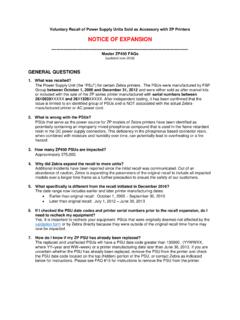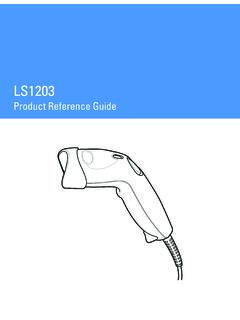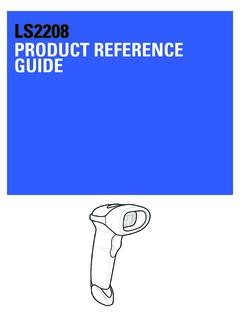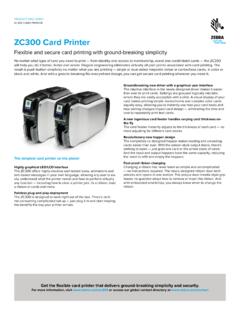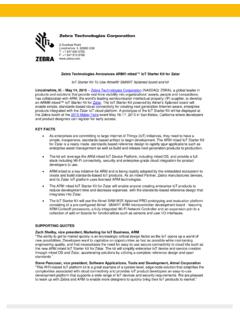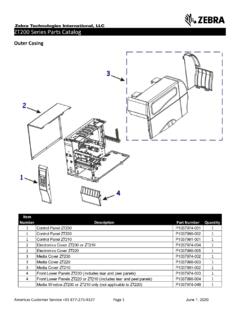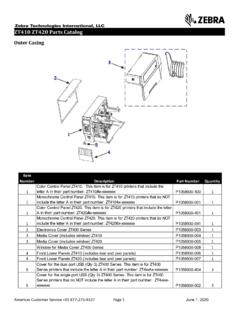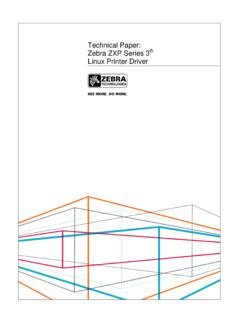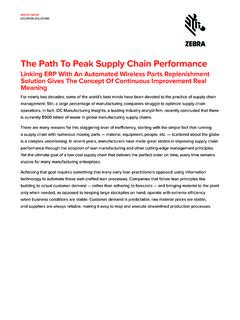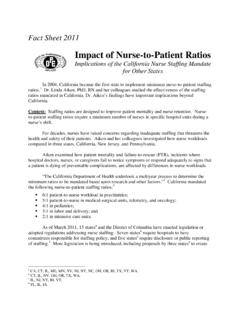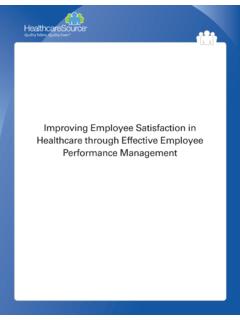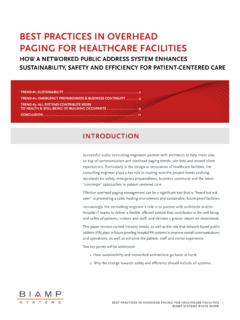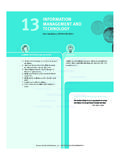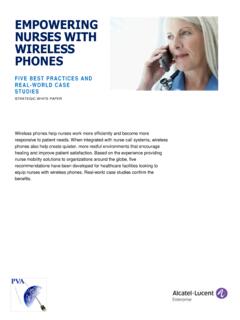Transcription of 2022 HOSPITAL VISION STUDY - Zebra Technologies
1 THE FUTURE OF HEALTHCARE:2022 HOSPITAL VISION STUDY MOBILE TECHNOLOGY ELEVATES PATIENT CARE, EMPOWERS CLINICIANS AND ENHANCES WORKFLOWS Bedside Nurses65%97%Physicians51%98%Pharmacists4 2%96%TRANSFORMATIVE TECHNOLOGY TRENDSEMERGENCE OF TECH-SAVVY PATI E NTSDELIVERING MEANINGFUL IMPROVEMENTSKIOSKS78%TABLETS2 Zebra Technologies HEALTHCARE IN 2022 Clinical mobility is transforming care at healthcare facilities around the world and is having a profound impact on nurses, doctors, IT executives and patients . Zebra commissioned three global research studies to better understand the role of technology in acute care hospitals. The studies focused on nurse managers, IT decision makers and recently hospitalized patients .
2 The Future of Healthcare 2022 HOSPITAL VISION STUDY summarizes the results of this analysis. Zebra s Healthcare VISION StudyRespondents identified compelling shifts in acute care hospitals and their impact on quality, cost and patient monitoringTelehealthArtificial Intelligence23177%Of patients felt positive about clinicians using mobile devices in their careExpanding use of Real-Time Locationing Service (RTLS) for dynamic staff workflows 83%GROWING USE OF MOBILE DEVICES CURRENT IMPACT OF MOBILE TECHNOLOGY:55%Of hospitals cite reduced cost of patient care72%Of hospitals highlight improved quality of patient care61%Of nurses report reduced medication administration errors57%Currently use wearables to track health metrics95%Willing to share health metrics collected from wearables with cliniciansOf nurses plan to access predictive analytics on mobile devices by 2022 COST REDUCTIONQUALITY IMPROVEMENTENHANCED PATIENT SAFETY96%Clinical Mobility is the use of mobile devices (such as handheld mobile computers, tablets and mobile printers) by physicians, nurses and other healthcare professionals at the point-of-care.
3 WHAT IS CLINICAL MOBILITY?CLINICAL MOBILITY IS THE ANSWERThe good news is that there is a solution that can help ease the stress on the system, improve patient care, create workflow efficiencies and better utilize limited resources. Thanks to the adoption of clinical mobility, hospitals around the world are eliminating manual, error-prone procedures and replacing them with digital solutions that increase the accuracy of patient identification, streamline processes, improve the quality of patient care and enhance overall visibility. By digitally capturing information, data can be transmitted in real time to clinical staff , reducing even eliminating errors and delivering critical time savings.
4 Expanding Use of Mobile DevicesHospitals are already realizing gains in productivity by outfitting key personnel with mobile devices. The STUDY showed that by 2022, 97% of nurses will use mobile devices at the bedside which will help instill greater patient confidence. The STUDY also revealed an increase in the number of medical disciplines embracing clinical mobility solutions including emergency room nurses, pharmacists and lab technicians. In fact, by 2020, usage of mobile devices is expected to grow up to 40% for all HOSPITAL workers. Rich applications, remote patient monitoring and artificial intelligence will enliven the daily work experience and empower clinicians with greater insights and information to treat staff CommunicationsAccording to The Joint Commission, 70% of medical errors are attributable to communication By integrating clinical mobility throughout their organizations, hospitals will improve staff communication , make real-time access to medical records possible and ensure faster availability of lab results, to name just a few.
5 Mobile devices enable nurses to spend more time at the patient s bedside. Over 65% of nurse managers and IT executives cite improved communication and collaboration as the primary benefit of clinical mobility in patient care. Elevating Patient CareAccording to the STUDY , 72% of respondents cite improved quality of patient care as a direct result of clinical mobility. In addition, 61% of hospitals surveyed reported a reduction in medication administration errors, and 52% cited decreased specimen collection labeling errors, positively affecting patient care. Rising Personalization of HealthcareThe digital HOSPITAL of the future won t just be more efficient, but it will also deliver better care, be more affordable and more deeply engage patients in their treatment and recovery.
6 Most respondents expect analytics technology to improve the quality of healthcare globally. In addition, tech-savvy patients are finding comfort in technology and are, in fact, bringing their data with them to the HOSPITAL . Ninety-five percent of patients surveyed are willing to share electronic health metrics. Zebra Technologies 31 The Joint Commission, global healthcare industry is facing a seemingly insurmountable number of challenges from aging populations and staff shortages to rising costs that are placing enormous pressure on institutions, doctors, workers, patients and communities. As a result, there is a higher demand for services and support that are not sustainable with existing resources and methods.
7 Hospitals are increasingly turning to technology and automation to reduce the strain on an already fragile system. EXECUTIVE SUMMARYFACTORS DRIVING INVESTMENT IN CLINICAL MOBILITY1 IMPROVE PATIENT OUTCOMES2 INCREASE staff WORKFLOW EFFICIENCY3 REDUCE THE COST OF PATIENT CARE4 COMPLY WITH NEW LAWS AND REGULATIONS5 OPTIMIZE PAYER REIMBURSEMENT (IN ONLY)4 Zebra Technologies DATA ACCESSED ON MOBILE DEVICESNURSES: TRADITIONAL HEALTHCARE HEROESN urses are the lifeline of the HOSPITAL . Nursing staff at 62% of hospitals surveyed currently access patient electronic health records on their mobile devices, followed by 57% who use mobile devices to access diagnostic lab results. By 2022, HOSPITAL staff anticipate using mobile devices and predictive analytics to improve diagnosis and personalize care.
8 IT PROFESSIONALS: THE GREAT FACILITATORS As clinical mobility finds a home in acute care HOSPITAL settings, the IT department s role will become even more complicated as they work to block security intrusions and ensure systems and devices work seamlessly. Currently, 36% of hospitals are using mobile devices and that number is expected to double by 2022, dramatically increasing the number of devices IT will need to manage. patients : EMERGING HEALTHCARE HEROES patients are embracing technology in healthcare. In particular, young, tech-savvy individuals are better informed and already using wearables to track their health data. The STUDY reveals that patients are becoming better prepared for their HOSPITAL stay with 48% making a list of questions and 46% checking online sources.
9 Of those responding in this manner, 68% were under 40 years of age. At the heart of creating a successful clinical mobility program is understanding the users who employ the devices in their day-to-day work environments as well as those they serve. These individuals include nurses, physicians, pharmacists, lab technicians, radiologists, patients and more. While nurses are actively engaged at the patient s bedside and use technology daily, it s the IT team that must implement and maintain the system while ensuring compliance with security and patient privacy requirements. patients must grow accustomed to technology s evolving role in their care. For some, this will be extraordinarily difficult. For more technologically astute patients , clinical mobility will not be a leap but quite possibly a EVOLVING HEALTHCARE ECOSYSTEM91%Electronic Health Records (EHRs)
10 Picture archiving and communication system, medical imagingPredictive analytics Lab diagnostic results88%76%69%68%98%Patient monitoring equipment52%98%Electronic Health Record notifications39%98%Biomedical devices33%97%Remote patient monitoring and health tracking informationNURSES IN 2022 ALERTS/ALARMS ACCESSED ON MOBILE DEVICESM edical and drug database references92%INTENSIVE CARE NURSE93%38%MOBILE DEVICE USAGE IS EXPECTED TO INCREASE DRAMATICALLYA ccording to the STUDY , by 2022 nurses across all disciplines bedside, emergency room, operating room and intensive care as well as physicians, pharmacists, and lab technicians will increasingly use mobile technology. In many cases, it is becoming an indispensable tool.
